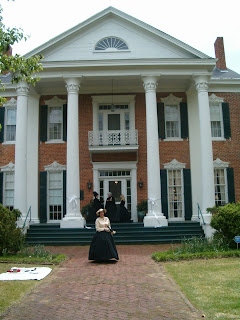


Because I am newly Southern, I am constantly learning about Southern ways. One such Southern tradition is the homage of Confederate veterans. To some, this ritual might seem outdated, but to the people who acknowledge it, Southern pride is alive and well.
Confederate Memorial Day was first observed after the Civil War ended. In 1866, a women's group in Alexandria, Virginia honored “Stonewall” Jackson by decorating his grave. Since then, cemeteries across the South are decorated during the month of April, which has been designated “Confederate Remembrance Month.” Fallen Confederate veterans’ graves are marked with small Confederate flags, and a formal service is performed. Each Southern state commemorates on a different designated day, but this may soon change, as a unified day will soon be chosen.
Nearly forty people attended the ceremony in Hernando, a small town that has seen its share of Civil War activity, and was Nathan Bedford Forrest’s stomping grounds. Members of the Sons of Confederate Veterans and the United Daughters of the Confederacy, who appeared in costume, were represented. During the service, flags from every Southern state were displayed. Various speakers were on hand to tell of the soldiers’ sufferings, and a trumpeter accompanied the presentation of wreaths with “Bonnie Blue Flag.” Men in gray gave the salute before the crowd sang “Dixie” in unison.
For some, this act of recognition would be fodder for jokes, and I recall the late George Carlin joking about how re-enactors should stop playing “Civil War.” “The war is over people!” he quipped. However, in my opinion, he seemed to be missing the point. In honor of their great-great grandfathers, men and women dress up in costume to keep the “War Between the States” alive, and enjoy teaching living history to school-age children. Their soldiers’ valor should never be forgotten. If it is, history could very well repeat itself.
I for one am impressed by the way Southerners display their pride. It isn’t something you’d see up North or in the West either, for that matter. After living in Colorado for twenty years, I never heard about a Confederate memorial service. Could be people are just too afraid of not being politically correct in these regions. It’s a shame, because all veterans are therefore lumped together, honored only on Memorial and Veterans Day holidays. This could be because the majority of Civil War battles took place in the South. I’m curious as to whether people in Pennsylvania and Maryland honor Southern heritage as well.
While standing under the flowering trees on Sunday, amidst azaleas and old faded marble headstones, I was moved by the ceremony. To me it was a poignant reminder, and a loving reverence to those men who served so long ago. May we never forget, and always honor them, for what they fought for was politically correct at the time.




